
Lower Austria is one of the nine states of Austria, located in the northeastern corner of the country. Since 1986, the capital of Lower Austria has been Sankt Pölten, replacing Vienna, which became a separate state in 1921. With a land area of 19,186 km2 (7,408 sq mi) and a population of 1.685 million people, Lower Austria is the second-most-populous state in Austria. Other large cities are Amstetten, Klosterneuburg, Krems an der Donau, Stockerau and Wiener Neustadt.
The Otselic River (aht-SEEL-ik), formerly known as Otselic Creek, is a 55.4-mile-long (89.2 km) tributary of the Tioughnioga River in central New York in the United States. It drains a hilly area, mostly forested and agricultural, east of the Finger Lakes at the northern edge of the Susquehanna River watershed.

The Leitha is a river in Austria and Hungary, a right tributary of the Danube. It is 120.8 km (75.1 mi) long. Its basin area is 2,138 km2 (825 sq mi).
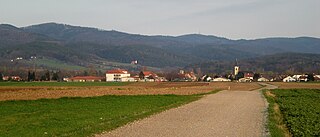
Lanzenkirchen is a market town in the district of Wiener Neustadt-Land in the Austrian state of Lower Austria.
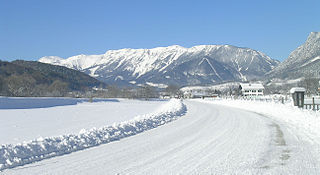
The Rax is a mountain range in the Northern Limestone Alps on the border of the Austrian federal provinces of Lower Austria and Styria. Its highest peak is the Heukuppe. The Rax, together with the nearby Schneeberg, are a traditional mountaineering and mountain walking area, and are called the Wiener Hausberge. They are separated by the deep Höllental.

Reichenau an der Rax is a market town in the Austrian state of Lower Austria, situated at the foot of the Rax mountain range on the Schwarza river, a headstream of the Leitha.
Bezirk Neunkirchen is a district of the state of Lower Austria in Austria. It is located at the south of the state.
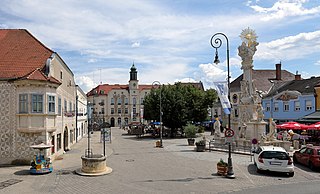
Neunkirchen is the capital of the district of Neunkirchen in the Austrian state of Lower Austria. As of 2020 it has a population of 12,721.

The market town of Winzendorf-Muthmannsdorf is an Austrian municipality in the district of Wiener Neustadt-Land in Lower Austria. It is situated some 64 km south of Vienna at the edge of the Southern Viennese Basin.

The Gutenstein Alps are a mountain range in the Eastern Alps in Central Europe, and the northeasternmost part of the Northern Limestone Alps, reaching heights over 1,000 m.

The Rax-Schneeberg Group is a mountain range in the Northern Limestone Alps on the Styrian-Lower Austrian border in Austria.

The Unterberg is a prominent summit, 1,342 m above sea level (AA) high, in the Gutenstein Alps in southern Lower Austria. It is located about 10 km south of Hainfeld and is the westernmost and highest summit of a loose chain of mountains that include the Hocheck (1,037 m) and the Kieneck (1,106 m). Its crest continues towards the southwest, albeit less high, to the Brunntaler Höhe (1,090 m) and the Leitermauern (1,025 m).

The Hohe Wand is a mountain ridge in Lower Austria and is part of the Gutenstein Alps. It lies west of Steinfeld in the Vienna Basin; its highest peak attains a height of 1,132 m. It is one of Vienna's Hausberge.

The Höllental in Lower Austria is a narrow valley between the steep limestone massifs of the Schneeberg and Rax through which the River Schwarza flows.

The Mürzsteg Alps or Mürztal Alps are a mountain range in the Eastern Alps, which lie in the Austrian state of Styria, with a small part of the range in Lower Austria. The highest peak is the Hohe Veitsch in the centre of the group, while largest massif is the Schneealpe in the northwest, near the Rax.

The Prealps East of the Mur are the easternmost mountain range of the Central Eastern Alps. They comprise the eastern foothills of the Alpine crest beyond the Mur river and the adjacent southeastern Alpine Foreland.
The Styrian-Lower Austrian Limestone Alps are the easternmost part of the Northern Limestone Alps, running from the River Enns to the Vienna Basin. The high Alpine, limestone massifs of the Hochschwab, Veitsch, Schneealpe, Rax and Schneeberg belong to it as do the limestone prealps to the north as far as the Flysch zone.
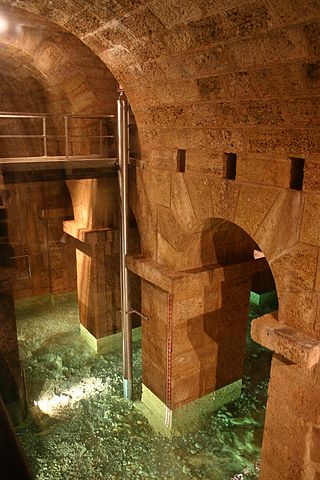
The First Vienna Mountain Spring Pipeline is a major part of Vienna's water supply and was the first source of safe drinking water for that city. The 95 km long line was opened on 24 October 1873, after four years of construction. Today, it delivers 62 million cubic meters of water per year. The water comes from high springs in the Rax and Schneeberg areas in Southern Lower Austria and Styria.

Vienna's Hausberge are the mountains of Raxalpe, Schneeberg and Hohe Wand in the south of the state of Lower Austria. These mountains may be reached from Vienna in about an hour and are therefore a popular recreation area for the Viennese.
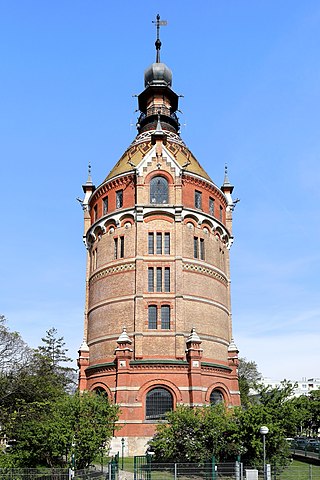
Water supply in Vienna is ensured by two high-source pipelines as well as various groundwater sources that are integrated into the pipeline system in exceptional cases. In total, up to 589,000 m³ of drinking water can thus be piped into the Austrian capital every day.





















